The Continuous Ketone Monitoring Market is estimated to be valued at USD 152.9 million in 2025 and is projected to reach USD 347.3 million by 2035, registering a compound annual growth rate (CAGR) of 8.6% over the forecast period.
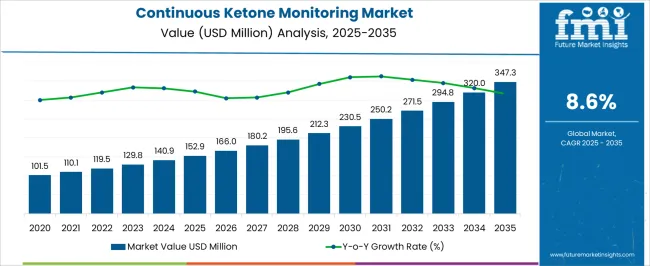
| Metric | Value |
|---|---|
| Continuous Ketone Monitoring Market Estimated Value in (2025 E) | USD 152.9 million |
| Continuous Ketone Monitoring Market Forecast Value in (2035 F) | USD 347.3 million |
| Forecast CAGR (2025 to 2035) | 8.6% |
The Continuous Ketone Monitoring market is experiencing strong growth, driven by increasing awareness of ketone levels in the management of diabetes, obesity, and metabolic disorders. The adoption of continuous monitoring systems is being fueled by the need for real-time, accurate measurements that enable timely interventions and improved patient outcomes. Advances in sensor technology, wearable devices, and cloud-based health analytics are enhancing device performance, reliability, and usability.
Integration with digital health platforms and mobile applications allows for seamless tracking, personalized insights, and remote monitoring by healthcare providers. Growing investment in healthcare infrastructure, particularly in hospitals and specialized clinics, is supporting broader market adoption. The focus on patient-centered care, preventive healthcare, and early detection of metabolic irregularities is further accelerating demand.
As the prevalence of lifestyle-related diseases rises globally and the emphasis on proactive disease management increases, continuous ketone monitoring devices are expected to gain wider acceptance Ongoing research and innovation in non-invasive sensing technologies, improved accuracy, and extended device lifespan are likely to drive sustained growth in the market over the coming decade.
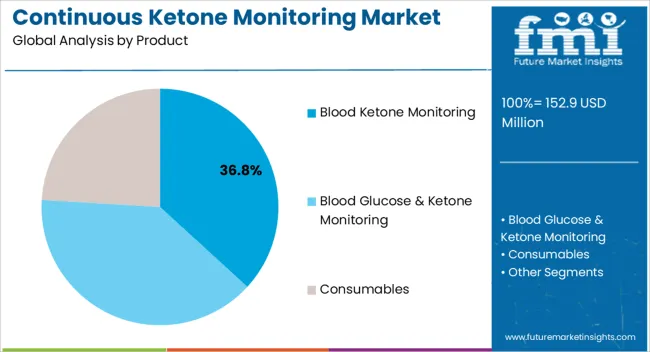
The blood ketone monitoring product segment is projected to hold 36.8% of the market revenue in 2025, establishing it as the leading product category. Growth is being driven by the high accuracy and reliability of blood-based measurements, which are essential for effective management of diabetes and metabolic disorders. Continuous monitoring of blood ketone levels allows timely interventions, reducing the risk of complications such as diabetic ketoacidosis.
The integration of advanced biosensors and digital reporting tools has enhanced usability and patient adherence. Real-time data can be shared with healthcare providers, supporting personalized treatment plans and preventive care strategies. The scalability and compatibility of blood ketone monitoring devices with wearable platforms further reinforce adoption.
As the prevalence of diabetes and metabolic disorders continues to rise, demand for precise, real-time monitoring solutions is expected to increase The combination of clinical reliability, user convenience, and integration with digital health ecosystems positions blood ketone monitoring as the leading product segment, supporting long-term market growth.
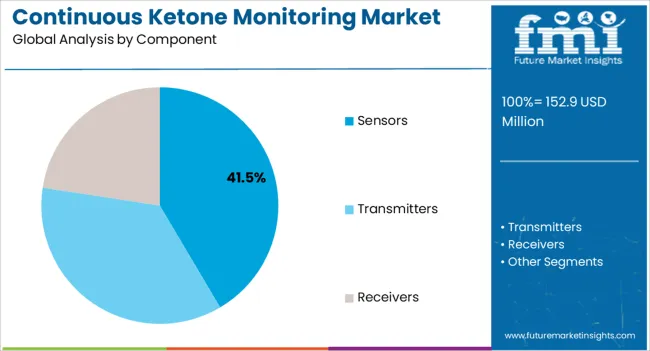
The sensors component segment is expected to account for 41.5% of the market revenue in 2025, making it the leading component category. Growth in this segment is being driven by the increasing reliance on high-precision sensing technologies that enable accurate, continuous ketone measurement. Advanced electrochemical and biosensor designs provide reliable data while minimizing discomfort for users, improving compliance and usability.
The integration of sensors with wearable devices and digital health platforms facilitates real-time monitoring, automated alerts, and remote patient management. Investments in research and development have enhanced sensor sensitivity, durability, and response time, which are critical for clinical applications.
As continuous ketone monitoring devices become more widely adopted in hospitals and outpatient care settings, demand for high-performance sensors is expected to remain strong The segment’s leadership is supported by its role in ensuring data accuracy, device reliability, and seamless interoperability with monitoring systems, making sensors the key enabler of market growth.
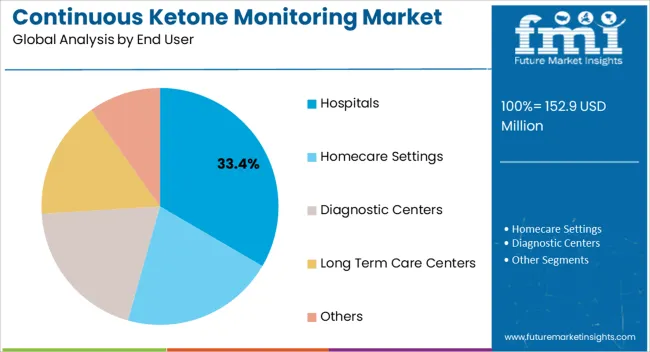
The hospitals end-user segment is projected to hold 33.4% of the market revenue in 2025, establishing it as the leading end-use category. Growth is being driven by the rising demand for continuous ketone monitoring in clinical settings to support patient management for diabetes, metabolic syndrome, and critical care applications. Hospitals leverage these devices to provide continuous, real-time monitoring that improves clinical decision-making, reduces complications, and enhances patient safety.
Integration with electronic health records and hospital information systems allows for seamless data management and longitudinal tracking of patient health. Increasing focus on preventive care, early intervention, and personalized treatment strategies has further reinforced adoption.
Investments in modern healthcare infrastructure, training programs, and advanced monitoring protocols are expanding device deployment across hospital networks As healthcare providers prioritize data-driven patient management and outcomes optimization, continuous ketone monitoring devices are expected to remain essential tools in hospitals, supporting sustained market growth and reinforcing the segment’s leading position.
From 2012 to 2025, the global continuous ketone monitoring market experienced a CAGR of 7.0%, reaching a market size of USD 152.9 million in 2025.
From 2012 to 2025, The emergence of the continuous ketone monitoring market in recent years is due to developments in wearable technology, sensor science, and growing consumer awareness of the benefits of ketone monitoring for a range of medical issues. The demand from those on ketogenic diets and athletes looking to improve their performance initially drove the industry.
Early on, the market was characterized by a small number of product options, higher prices, and a concentration on specialized applications. Athletes who needed accurate ketone level monitoring or those with diabetes managing their risk of diabetic ketoacidosis (DKA) were the main users of continuous ketone monitoring devices.
Future Forecast for Continuous Ketone Monitoring Industry:
Looking ahead, the global continuous ketone monitoring industry is expected to rise at a CAGR of 9.0% from 2025 to 2035. During the forecast period, the market size is expected to reach USD 347.3 million by 2035.
The continuous ketone monitoring industry is expected to continue its growth trajectory from 2025 to 2035, The need for continuous ketone monitoring devices is anticipated to increase due to the rising prevalence of diabetes around the world and the need for effective DKA therapy and prevention. By providing real-time ketone level monitoring, these gadgets help people with diabetes take control of their disease and prevent complications.
| Country | The United States |
|---|---|
| Market Size (USD million) by End of Forecast Period (2035) | USD 347.3 million |
| CAGR % 2025 to End of Forecast (2035) | 9.4% |
The continuous ketone monitoring industry in the United States is expected to reach a market size of USD 347.3 million by 2035, expanding at a CAGR of 9.4%. The USA has a high prevalence of diabetes, with a large population of individuals living with the condition.
As diabetes management becomes a priority, there is a growing demand for continuous ketone monitoring devices to help individuals monitor their ketone levels more effectively, especially those at risk of diabetic ketoacidosis (DKA).
| Country | The United Kingdom |
|---|---|
| Market Size (USD million) by End of Forecast Period (2035) | USD 15.2 million |
| CAGR % 2025 to End of Forecast (2035) | 7.9% |
The continuous ketone monitoring industry in the United Kingdom is expected to reach a market share of USD 15.2 million, expanding at a CAGR of 7.9% during the forecast period. The healthcare system in the UK places a strong emphasis on diabetes management and prevention of complications.
Continuous ketone monitoring devices play a vital role in supporting diabetes management by providing real-time ketone level data, enabling timely interventions and adjustments to diabetes treatment plans.
| Country | China |
|---|---|
| Market Size (USD million) by End of Forecast Period (2035) | USD 23.6 million |
| CAGR % 2025 to End of Forecast (2035) | 9.5% |
The continuous ketone monitoring industry in China is anticipated to reach a market size of USD 23.6 million, moving at a CAGR of 9.5% during the forecast period.
China's healthcare expenditure has been rising steadily, driven by economic growth and government efforts to improve healthcare infrastructure. This increased investment in healthcare facilities and services creates opportunities for the growth of the continuous ketone monitoring market.
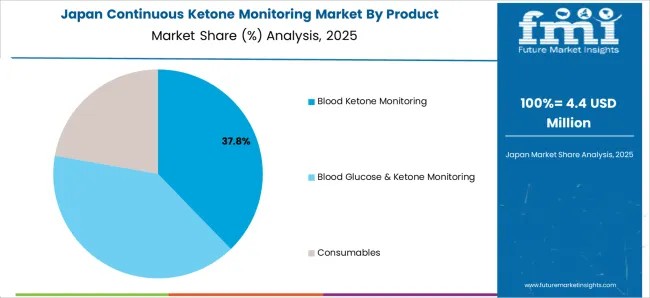
| Country | Japan |
|---|---|
| Market Size (USD million) by End of Forecast Period (2035) | USD 13.6 million |
| CAGR % 2025 to End of Forecast (2035) | 8.2% |
The continuous ketone monitoring industry in Japan is estimated to reach a market size of USD 13.6 million by 2035, thriving at a CAGR of 8.2%. Japan has a robust regulatory framework for medical devices, ensuring the safety and efficacy of products in the market. Supportive regulations and guidelines facilitate the introduction and commercialization of continuous ketone monitoring devices, driving market growth.
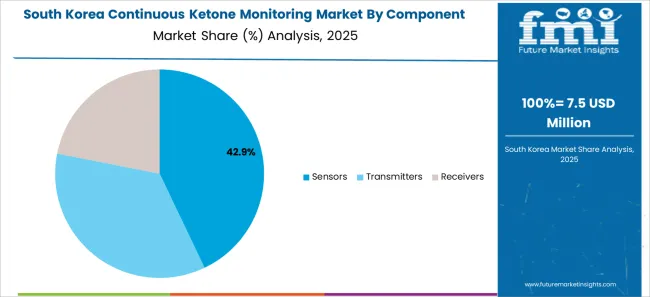
| Country | South Korea |
|---|---|
| Market Size (USD million) by End of Forecast Period (2035) | USD 12.0 million |
| CAGR % 2025 to End of Forecast (2035) | 8.8% |
The continuous ketone monitoring industry in South Korea is expected to reach a market size of USD 12.0 million, expanding at a CAGR of 8.8% during the forecast period. Ongoing research and development efforts in South Korea's medical device industry contribute to the growth of the continuous ketone monitoring market. Domestic manufacturers focus on developing innovative and advanced continuous ketone monitoring devices to cater to the specific needs and preferences of the South Korean market.
The blood ketone monitoring is expected to dominate the continuous ketone monitoring industry with a CAGR of 9.2% from 2025 to 2035. Blood ketone monitoring provides direct and accurate measurement of ketone levels in the bloodstream.
It allows individuals with diabetes to obtain real-time information about their ketone levels, enabling them to make timely decisions and take appropriate actions to manage their condition effectively. By offering unique insights into ketone levels, blood ketone monitoring offers individualized diabetes management. Individuals can improve their glycemic control and avert problems by modifying their diet, insulin dosage, and overall diabetes management strategy by recognizing their particular ketone response.
The sensors components segments are expected to dominate the continuous ketone monitoring industry with a CAGR of 9.6% from 2025 to 2035. Sensors are responsible for accurately measuring ketone levels in continuous ketone monitoring devices.
They utilize various detection methods, such as enzymatic or electrochemical reactions, to convert the presence of ketones into measurable signals. This accuracy ensures reliable and precise ketone measurements, allowing individuals with diabetes to monitor their ketone levels with confidence.
The hospital segment is expected to dominate the continuous ketone monitoring industry with a CAGR of 8.6% from 2025 to 2035. Hospitals serve as the primary point of diagnosis and treatment for individuals with diabetes and related conditions. Continuous ketone monitoring devices are utilized in hospital settings to monitor ketone levels in patients, especially those at risk of diabetic ketoacidosis (DKA). Hospitals play a crucial role in the adoption and implementation of continuous ketone monitoring devices for accurate ketone level assessment and timely intervention.
Hospitals often conduct clinical research and studies related to diabetes management and monitoring. Continuous ketone monitoring devices are used in these research projects to gather data and evaluate their effectiveness in improving patient outcomes.
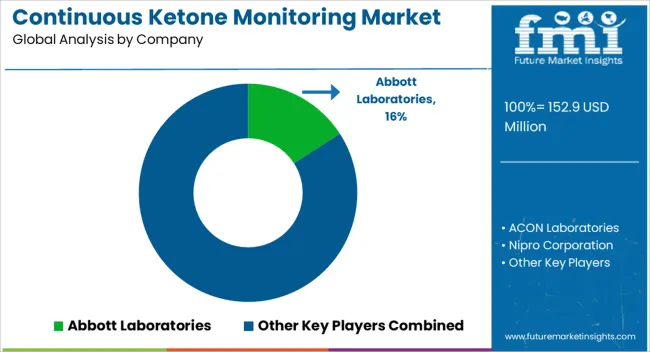
The continuous ketone monitoring sector is fiercely competitive, with many companies fighting for market dominance. To stay ahead of the competition in such a circumstance, essential players must employ smart techniques.
Key Strategies Used by the Participants
Product Development
Companies invest heavily in R&D to deliver novel products that improve efficiency, dependability, and cost-effectiveness. Product innovation allows businesses to differentiate themselves from their competition while also catering to the changing demands of their clients.
Strategic Alliances & Collaborations
Strategic alliances and partnerships with other businesses are regularly formed by major players in an industry to take advantage of each other's advantages and expand their market reach. Through such arrangements, businesses may also obtain access to new technologies and markets.
Expansion into Emerging Markets
The continuous ketone monitoring sector is expanding rapidly in emerging regions such as China and India. Key firms are enhancing their distribution networks and developing local manufacturing facilities to increase their presence in these areas.
Acquisitions and mergers
Mergers and acquisitions are frequently used by key players in the continuous ketone monitoring business to consolidate their market position, extend their product range, and gain access to new markets.
Key Developments in the Continuous Ketone Monitoring Market:
In June 2025, Abbott (NYSE: ABT) revealed it is working on a novel biowearable that combines a sensor for continuous glucose and ketone monitoring. The system has received the USA Food and Drug Administration's breakthrough device designation, which is intended to speed up the examination of novel technologies that can enhance the lives of patients with life-threatening or permanently disabling diseases or disorders.
The global continuous ketone monitoring market is estimated to be valued at USD 152.9 million in 2025.
The market size for the continuous ketone monitoring market is projected to reach USD 347.3 million by 2035.
The continuous ketone monitoring market is expected to grow at a 8.6% CAGR between 2025 and 2035.
The key product types in continuous ketone monitoring market are blood ketone monitoring, blood glucose & ketone monitoring and consumables.
In terms of component, sensors segment to command 41.5% share in the continuous ketone monitoring market in 2025.






Our Research Products

The "Full Research Suite" delivers actionable market intel, deep dives on markets or technologies, so clients act faster, cut risk, and unlock growth.

The Leaderboard benchmarks and ranks top vendors, classifying them as Established Leaders, Leading Challengers, or Disruptors & Challengers.

Locates where complements amplify value and substitutes erode it, forecasting net impact by horizon

We deliver granular, decision-grade intel: market sizing, 5-year forecasts, pricing, adoption, usage, revenue, and operational KPIs—plus competitor tracking, regulation, and value chains—across 60 countries broadly.

Spot the shifts before they hit your P&L. We track inflection points, adoption curves, pricing moves, and ecosystem plays to show where demand is heading, why it is changing, and what to do next across high-growth markets and disruptive tech

Real-time reads of user behavior. We track shifting priorities, perceptions of today’s and next-gen services, and provider experience, then pace how fast tech moves from trial to adoption, blending buyer, consumer, and channel inputs with social signals (#WhySwitch, #UX).

Partner with our analyst team to build a custom report designed around your business priorities. From analysing market trends to assessing competitors or crafting bespoke datasets, we tailor insights to your needs.
Supplier Intelligence
Discovery & Profiling
Capacity & Footprint
Performance & Risk
Compliance & Governance
Commercial Readiness
Who Supplies Whom
Scorecards & Shortlists
Playbooks & Docs
Category Intelligence
Definition & Scope
Demand & Use Cases
Cost Drivers
Market Structure
Supply Chain Map
Trade & Policy
Operating Norms
Deliverables
Buyer Intelligence
Account Basics
Spend & Scope
Procurement Model
Vendor Requirements
Terms & Policies
Entry Strategy
Pain Points & Triggers
Outputs
Pricing Analysis
Benchmarks
Trends
Should-Cost
Indexation
Landed Cost
Commercial Terms
Deliverables
Brand Analysis
Positioning & Value Prop
Share & Presence
Customer Evidence
Go-to-Market
Digital & Reputation
Compliance & Trust
KPIs & Gaps
Outputs
Full Research Suite comprises of:
Market outlook & trends analysis
Interviews & case studies
Strategic recommendations
Vendor profiles & capabilities analysis
5-year forecasts
8 regions and 60+ country-level data splits
Market segment data splits
12 months of continuous data updates
DELIVERED AS:
PDF EXCEL ONLINE
B-Ketone Monitoring System Market Size and Share Forecast Outlook 2025 to 2035
Continuous Cardiac Monitoring Devices Market Size and Share Forecast Outlook 2025 to 2035
Continuous Glucose Monitoring Device Market - Demand & Future Trends 2025 to 2035
Continuous Hormone Monitoring Market Analysis - Size, Share, and Forecast Outlook 2025 to 2035
Continuous Glucose Monitoring Systems Market is segmented by transmitters and monitors, sensors and insulin pump from 2025 to 2035
Continuous Emission Monitoring System Market Growth - Trends & Forecast 2025 to 2035
Real Time Continuous Microbiological Monitoring Systems Market
Continuous Inkjet Inks Market Forecast and Outlook 2025 to 2035
Monitoring Tool Market Size and Share Forecast Outlook 2025 to 2035
Continuously Variable Transmission (CVT) Market Size and Share Forecast Outlook 2025 to 2035
Continuous Ambulatory Peritoneal Dialysis Bags Market Size and Share Forecast Outlook 2025 to 2035
Continuous Motion Cartoner Market Size and Share Forecast Outlook 2025 to 2035
Continuous Flow Bioreactors Market Analysis - Size, Share, and Forecast Outlook 2025 to 2035
Continuous Inkjet Printers Market Size and Share Forecast Outlook 2025 to 2035
Continuous Friction Tester Market Size and Share Forecast Outlook 2025 to 2035
Continuous Fryer Machine Market Size and Share Forecast Outlook 2025 to 2035
Continuous Positive Airway Pressure (CPAP) Market Analysis – Size, Share & Forecast Outlook 2025 to 2035
Continuous Miners Market Growth - Trends & Forecast 2025 to 2035
Continuous Renal Replacement Therapy Market Growth – Trends & Forecast 2025-2035
Continuous Peripheral Nerve Block Catheter Market Growth – Trends & Forecast 2025-2035

Thank you!
You will receive an email from our Business Development Manager. Please be sure to check your SPAM/JUNK folder too.
Chat With
MaRIA